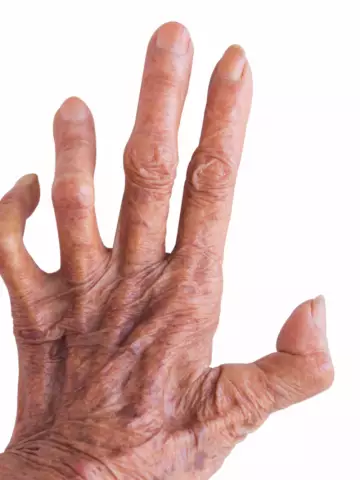- Author Rachel Wainwright [email protected].
- Public 2023-12-15 07:39.
- Last modified 2025-11-02 20:14.
Leprosy

Lepra is a chronic infectious disease caused by the acid-fast mycobacterium leprosy (Hansen-Neisser bacillus). This infection mainly affects the skin, peripheral nervous system, eyes and internal organs. There are currently more than two million leprosy patients in the world. Men get this disease twice as often as women. Leprosy can get sick at any age, but children under one year old get sick very rarely.
Leprosy is not very contagious. The only reservoir of leprosy is a sick person. Infection with an infection occurs by airborne droplets or through direct contact with a patient.
Clinical symptoms of leprosy
Immunological and clinical manifestations of the disease are characterized by a wide variety (from tuberculoid forms of infection to lepromatous). The first symptoms of leprosy disease usually appear on the skin of a person in the form of one or more hypopigmented or hyperpigmented plaques or spots. In the area of skin lesion, partial or complete loss of sensitivity most often occurs. In contact with a patient in a healthy person, single lesions with reduced sensitivity may appear on the skin. The affected areas of the skin can spontaneously disappear within a few years, but even in this case, you cannot do without specific treatment. With early tuberculoid leprosy, clearly demarcated spots of hypopigmentation of the skin appear. Later, the lesions increase, their edges are rounded and raised,acquiring an annular shape. Nerve damage leads to muscle atrophy. Contractures of the foot and hand are very common. Damage to the facial nerves often leads to lagophthalmos, keratitis and corneal ulceration, leading to loss of vision.
In lepromatous leprosy, lesions are represented by hypopigmented spots, nodules, plaques, or papules. The boundaries of the lesions are not clearly delineated, and their central sections are slightly raised above the surface of the skin, convex and compacted, and not concave, as in tuberculoid leprosy. Diffuse infiltration is usually observed between the lesions. Ears, face (eyebrows, cheeks, nose), elbow joints, wrists, knees and buttocks are considered the favorite sites for localization of lesions in lepromatous leprosy. At this stage of the disease, the lateral areas of the eyebrows very often fall out, and later the ear lobes sag, and the skin of the face wrinkles and thickens (lion's face).
The early symptoms of leprosy are shortness of breath, nosebleeds, hoarseness, laryngitis, and obstruction of the nasal passages. With damage to the anterior part of the eyes, iridocyclitis and keratitis develop. In men, scarring and infiltration of the testicles leads to infertility. A very common symptom of leprosy is the development of a saddle nose as a result of perforation of the nasal septum and the formation of a small depression in the middle of the nasal dorsum.
Leprosy treatment

In 1943, sulfone drugs were proposed to treat leprosy. In addition to them, ethyl mercaptan compounds or thiourea derivatives, the antibiotic Rifadin and isonicotinic acid derivatives are prescribed.
The antibiotic Rifadin has a high antileprosy activity and good tolerance when taken orally. The antibiotic is easily absorbed from the digestive tract, penetrating into the tissues of the body. This drug is especially effective for lepromatous leprosy. It provides fast bacteriological negativity.
Leprosy should be treated with multiple drugs. Usually these are Rifadin, Clofazimine and Dapsone. The combination of Rifadin and Dapsone will be quite effective for borderline lepromatous and borderline forms of the disease. In the lepromatous form of the disease, it is advisable to use all three drugs. In the course of leprosy treatment, objective methods should be used to assess the effectiveness of the therapy, including biopsies and scrapings. Treatment of the disease must be continued until persistently negative results are obtained using laboratory diagnostic methods. The optimal duration of treatment has not been established, but it is recommended to adhere to the therapeutic regimen for at least two years.
Prevention of leprosy
Infection of a child with leprosy disease does not occur in utero, but only through contact with the mother. To avoid contamination of the newborn, it should be isolated from the mother immediately after birth.
Individuals who have been in contact with a patient with leprosy for a long time should be especially carefully examined. The patient's closest relatives need to do a lepromin test. In areas where outbreaks have been identified, mass vaccinations with the BCG anti-tuberculosis vaccine should be carried out. The identified patients must be isolated in clinics for rational therapy.
YouTube video related to the article:
The information is generalized and provided for informational purposes only. At the first sign of illness, see your doctor. Self-medication is hazardous to health!






